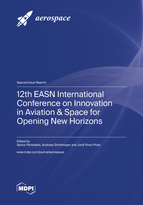Hydrogen-Powered Aviation—Design of a Hybrid-Electric Regional Aircraft for Entry into Service in 2040
Round 1
Reviewer 1 Report
The paper deals with the design of a hybrid hydrogen-electric aircraft intended for short-haul flights for an expected number of 50 passengers.
Comments:
The passenger weight of approximately 106 kg is taken into account in the TLAR calculation. Including baggage, which may be a problem in 2040 and beyond as the human population changes over time in terms of weight as well as height.
When calculating TLAR, has the crew also been considered?
The article mentions the ATR - 72 and ATR - 42 models, among others. Is there a fundamental difference between them or are they comparable in your calculations?
Is the propeller configuration at the wingtip supported by the calculation in terms of efficiency and stability?
Are you planning to develop a model for aerodynamic tests and basic flight tests?
Author Response
Please see attachment!
Author Response File: ![]() Author Response.pdf
Author Response.pdf
Reviewer 2 Report
The authors have reported on design of a hybrid-electric regional aircraft. The paper is interesting and reasonably well written. There is a lot of interest in hybrid-electric aircraft currently and therefore, the content of the paper is very relevant. However, the paper needs to be improved. The paper can be considered for publication after a revision.
The following should be addressed in the revised paper:
1. Line 2. Change "Motivated by the challenges, this paper focuses on how a 50-passenger regional aircraft ..." to "Motivated by these challenges, this paper explores how a 50-passenger regional aircraft ..."
2. Line 6. Change "To realize a feasible concept for the near future under aspects of performance and security, the system must be hybridized." to "To realize a feasible concept in the near future considering the aspects of performance and security, the system must be hybridized."
3. Line 19. Change "Despite numerous crises in the 21st century, air traffic has the tendency on growing continuously" to "Despite numerous crises in the 21st century, air traffic has been growing continuously"
4. Line 25. Change "contribution" to "contributing"
5. Line 43, Change "In the final Section 4, ..." to "Finally, in Section 4 ..."
6. The paper lacks on the aerodynamics and structural aspects of the design. The discussion is mostly focused on the performance aspects of the design.
7. Has any basic aerodynamic and/or structural analysis has been done to support the design.
8. Is HAIQU designed around an existing aircraft? If so, please discuss the differences and/or similarities between the aircrafts.
Author Response
Please see attachment!
Author Response File: ![]() Author Response.pdf
Author Response.pdf
Round 2
Reviewer 1 Report
Thank you for writing the responses to the review and completing the manuscript.
Reviewer 2 Report
The authors have addressed all the concerns raised in the review report. The paper can be recommended for publication.





